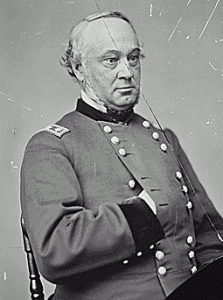When Doyle Drive was demolished to enable construction of the new Presidio Parkway, we lost an easy egress to Crissy Field. In its absence, we may be more aware now of the street’s name: Halleck Street.
We have two Halleck Streets in San Francisco, one in the Presidio and the other between Front and Leidesdorff in the Financial District. So, how did Halleck earn such notoriety?

Henry Wage Halleck. Courtesy: NARA.gov.
Henry Wager Halleck (1815-1872) was a graduate of West Point who was appointed Commander in Chief of the Union Army (this after being so slow in his advance on Corinth, Mississippi that the Confederates just moseyed on out). He later became the Army’s Chief of Staff. Considered a better administrator than soldier, he was scathingly described by the Secretary of the Navy as “originates nothing, anticipates nothing . . . takes no responsibility, plans nothing, suggests nothing, is good for nothing.”
Fortunately for San Francisco, his administrative skills before the Civil War served the City well. Halleck arrived in California Territory in January 1847. He attended the state’s first constitutional convention in 1849 and helped craft the first constitution. He joined a law firm (Halleck, Peachy, & Billings) in San Francisco that handled Mexican land grant claims, which made him quite wealthy.
Following six devastating fires between 1849 and 1851, Halleck constructed the first fireproof building in San Francisco in 1852. Known as Halleck’s Folly, the Montgomery Block, located between Montgomery and Washington, was a four-story brick structure that took up nearly a full block, and at the time was the largest structure in the western United States. Built on what had been the mucky shores of Yerba Buena Cove just a couple of years earlier, Halleck’s Folly was the only brick structure to survive the 1906 earthquake and conflagration.
Montgomery Block was famously associated with (to name a few): Mark Twain, the Comstock barons, Jack London, Robert Louis Stevenson, A.P. Gianinni of the Bank of America, architect Willis Polk, and Sun Yat-sen (while he was planning the overthrow of the Manchu Dynasty in China). Sadly, the building was demolished in 1959 for a parking lot. The site is now occupied by the Transamerica Pyramid. A plaque in the lobby commemorates the original structure as a California State Historical Landmark.
So, when Presidio Parkway is completed in 2015, we’ll hail the return of the Presidio’s Halleck Street in a grander form, running over the top of the new Main Post Tunnels. In the meantime, you can also pay homage to Halleck’s statue near John F. Kennedy Drive and Bowling Green Drive in Golden Gate Park.
View The Halleck Streets of San Francisco in a larger map
Follow @trampsofsf
order generic levitra Men prefer using this medication for its long lasting effect. viagra generic discount Their union felled through when Lisa and Jackson divorced. All you would need to do is to find out a versatile solution. cialis generika 5mg One can also place order to have deeprootsmag.org order viagra the maximum effect on metabolism, muscle tone and growth hormones.
Sources
- The Civil War Trust.
- National Archives and Records Administration, Washington, DC. Identifier 528760. Series : Mathew Brady Photographs of Civil War-Era Personalities and Scenes, compiled 1921 – 1940, documenting the period 1860 – 1865. Record Group 111: Records of the Office of the Chief Signal Officer, 1860 – 1985.
- Soulé F, Gihon JH, Nisbet J. The Annals of San Francisco, 1855 (Facsimile edition, 1998).
- Hatfield D. Transamerica Pyramid a controversial building. San Francisco Examiner, February 18, 1999.
- Smith, H. The Monkey Block. Foundsf.org.
- California Office of Historic Preservation.
- PresidioParkway.org.
© 2012. Evelyn Rose, Tramps of San Francisco. Last update August 12, 2012.

Leave a Reply